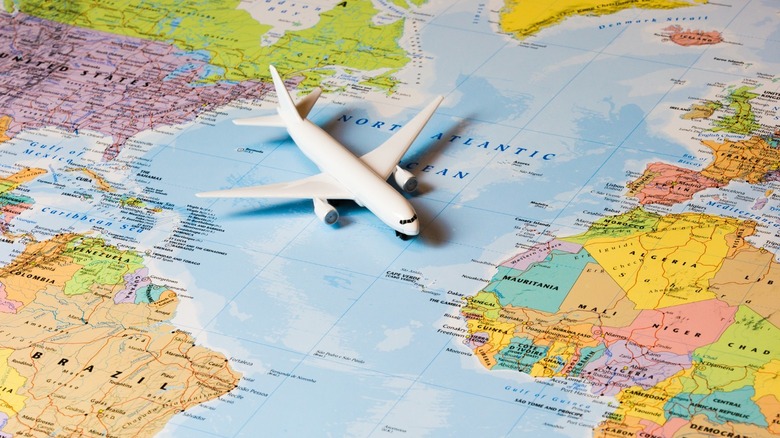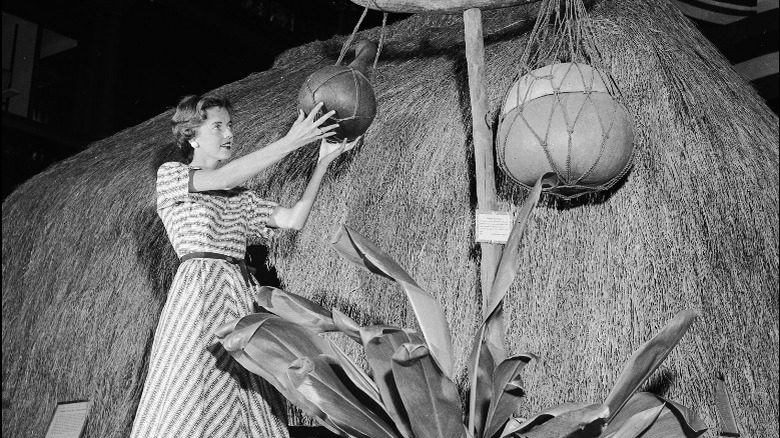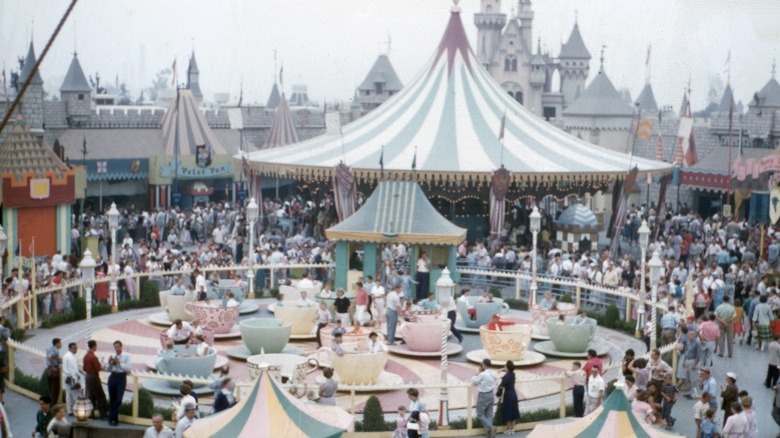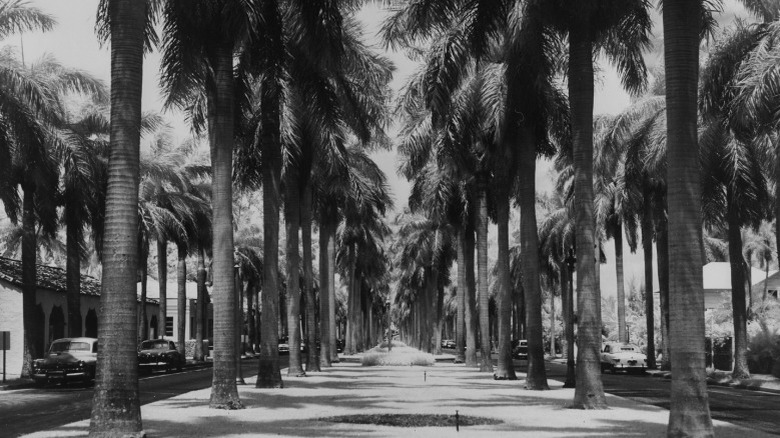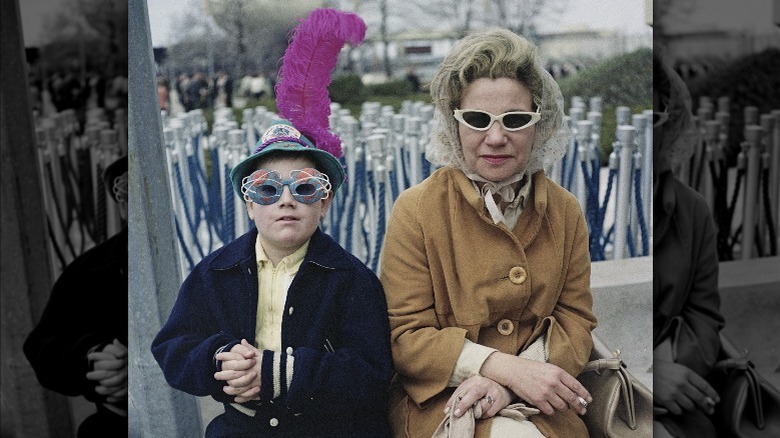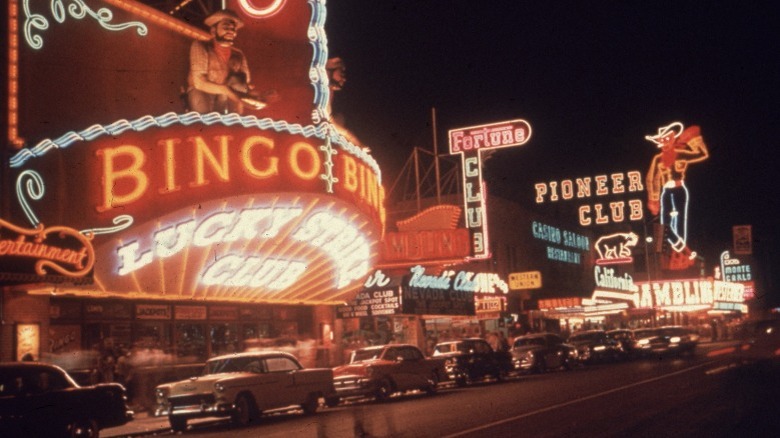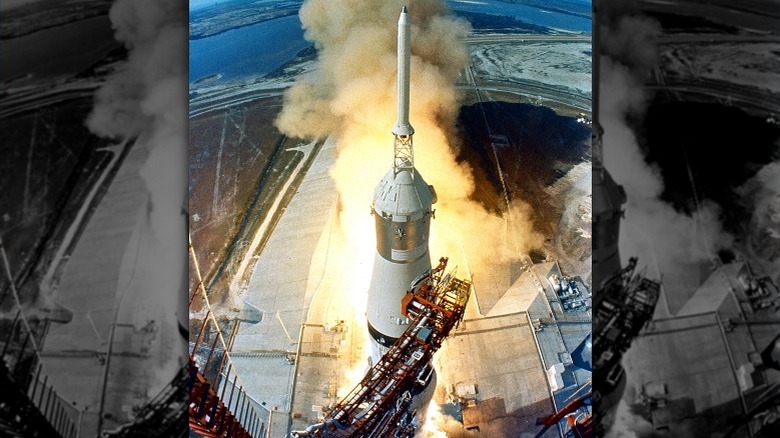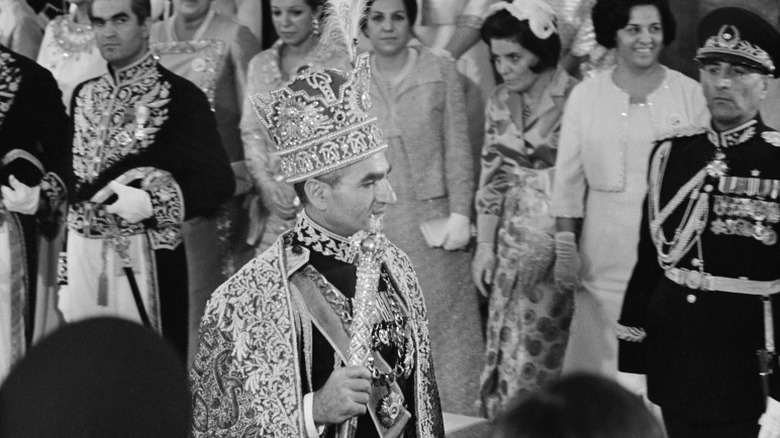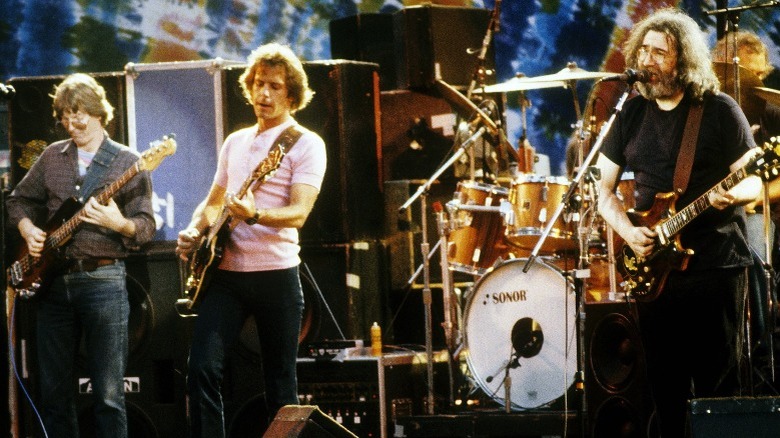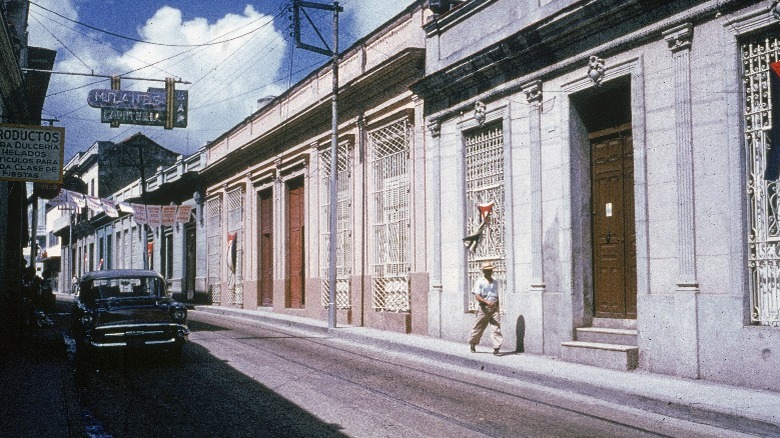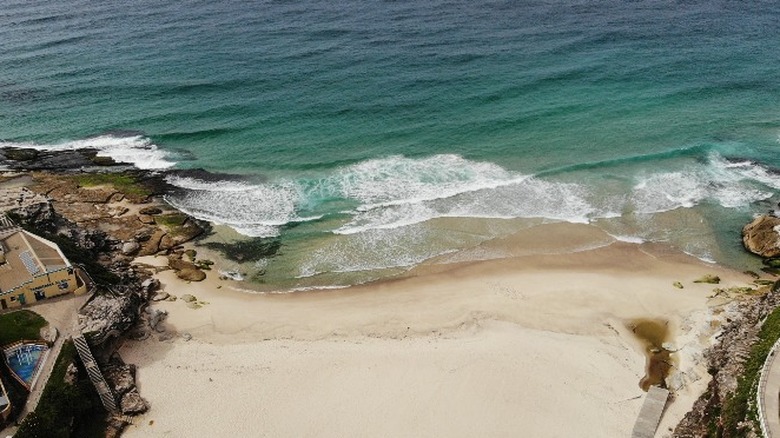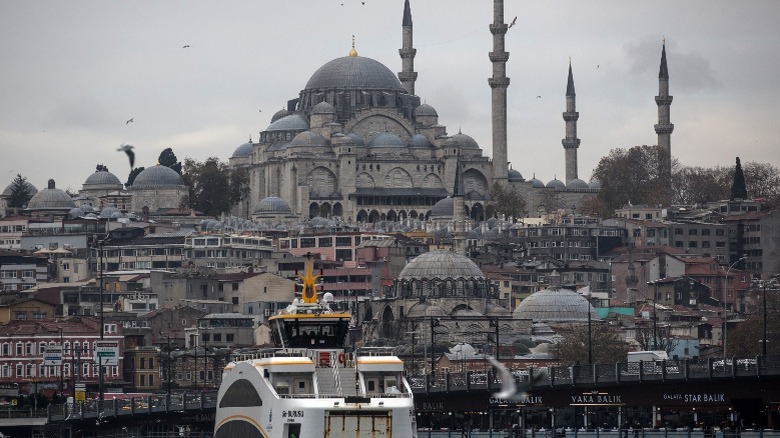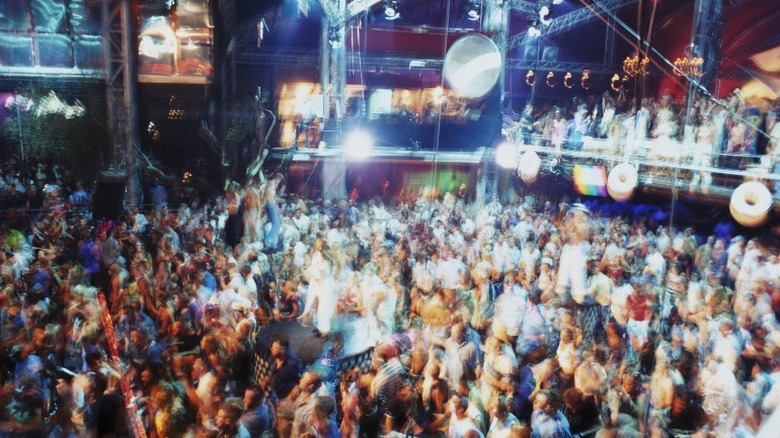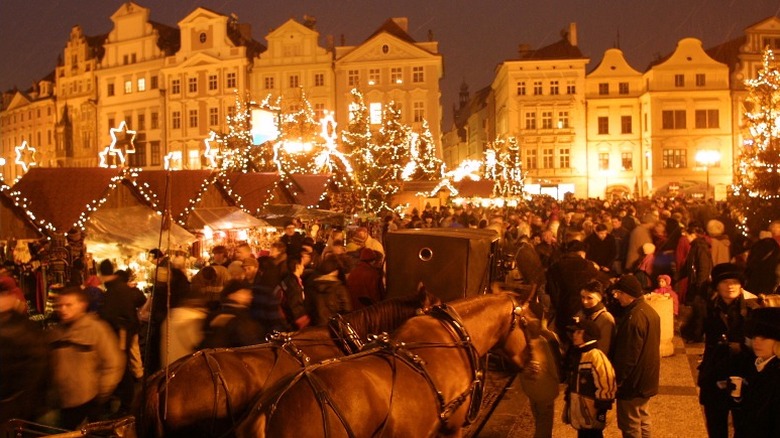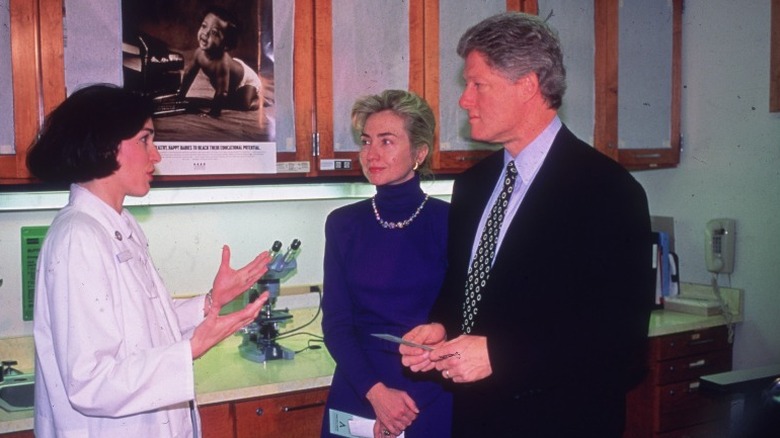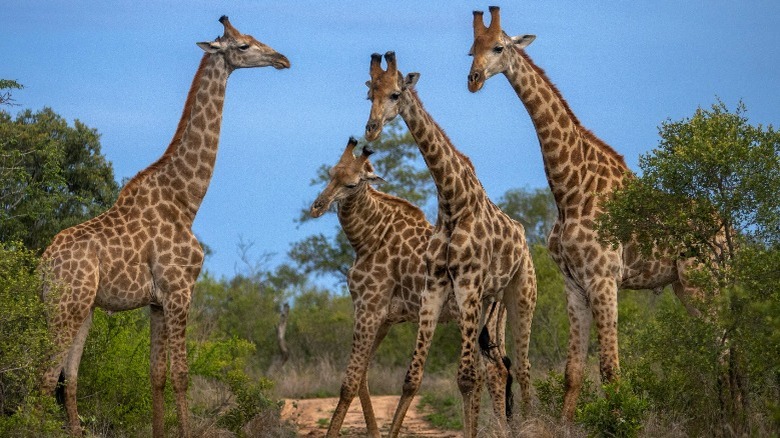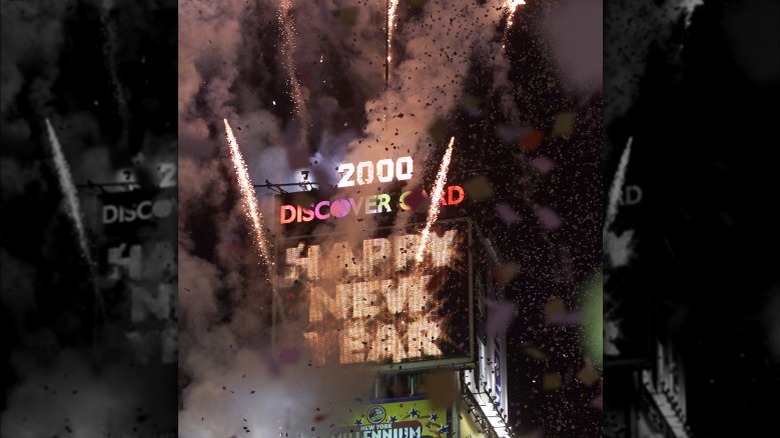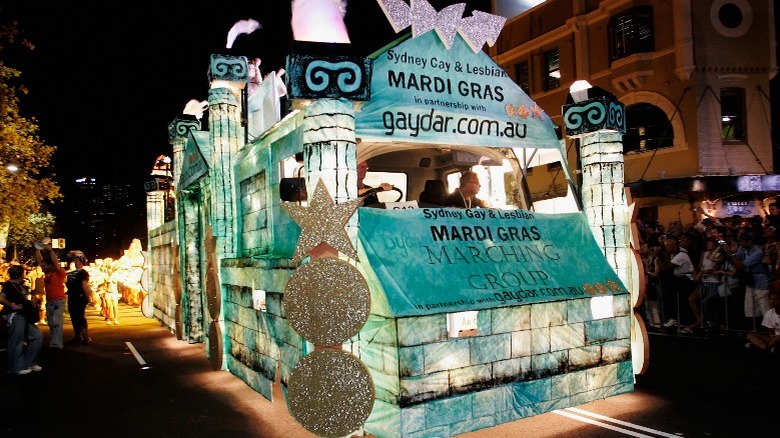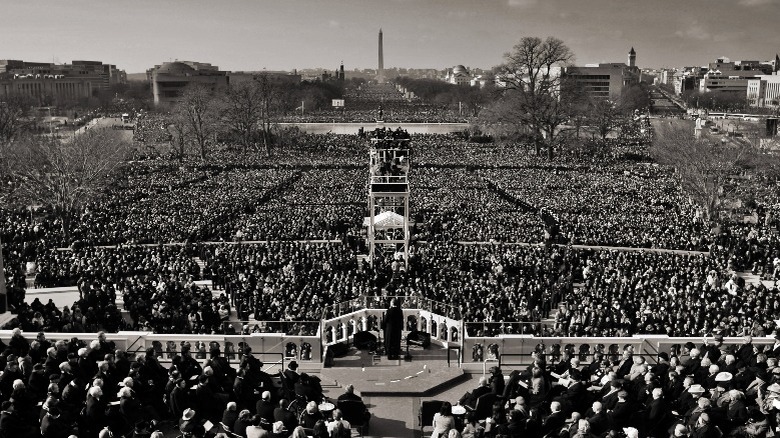The Most Popular Vacation Spots For Americans The Year You Were Born
For many Americans, the warm days of summer often bring back memories of past vacations to favorite destinations. Whether they were family road trips, cross-country excursions, or international explorations, they flood the minds of yesteryear's youth with nostalgia and sentimentality. As times have changed and traveling large distances has become easier and easier with the advance of technology, vacation destinations have become more and more extravagant. Many cities and towns revolve almost entirely around tourism, surviving on an ever-changing cast of characters stopping by for, mostly, ephemeral visits. Places that were previously only known only to a precious few locals are now some of the most well-trodden destinations in the entire world.
Over the past 70 years, many different spots have seen their popularity come and go, while some have managed to hang on as must-see tourist destinations. It seems like every year there is a new popular place to travel to, highlighted by a unique event or an assortment of attractions. Let's take a look back at some of the most popular vacation spots for Americans the year you were born.
1950: Honolulu, Hawaii
The beautiful islands of Hawaii have long been one of the most sought out vacation areas for Americans, and in 1950, Honolulu on the island of Oahu was the top spot. Less than 10 years after the bombing of Pearl Harbor in Honolulu on the island's southern coast, and nine years before it would be admitted to the Union in 1959, Americans flocked to Honolulu in huge numbers. Not only did average families (who could afford it) travel to Hawaii for vacation that year, but even President Harry Truman and members of his cabinet enjoyed a few days in the sun in Honolulu while attending a conference in the Pacific (per the New York Times).
Besides the beautiful weather and incredible scenery, travelers came to Hawaii to pay their respect to 2,400 Americans who were killed during the bombing of Pearl Harbor in late 1941. They could go to the site where the USS Arizona had been, and see a flagpole and commemorative plaque memorializing the tragedy (via the National Parks Service). On the coast of Honolulu, in the Waikiki neighborhood, families often chose to stay at the famous Moana Hotel, a luxurious resort and launching pad for the show "Hawaii Calls." "Hawaii Calls" was a famous radio program that ran from 1935-1975 (with a brief interruption during World War II), and featured recordings of the waves breaking on the beach to attract listeners.
1952: Tel Aviv, Israel
In 1952, just four years after gaining independence from the British, Tel Aviv, Israel, was already a tourist hotspot. Located on the coast of Israel, halfway between the city of Haifi and the Gaza Strip, Tel Aviv has long been known for its beautiful beaches and incredible scenery. Two years prior to 1952, Tel Aviv and the major port of Jaffa had united to create Tel Aviv-Jaffa, which increased the coastline belonging to Tel Aviv (via Aaron Golan). According to Haaretz, the total Tel Aviv coastline is an incredible 14 km long and is composed of 13 separate beaches. While the atmosphere and feeling have certainly changed in the 70 years since 1952, the natural beauty and vivid landscape have always been incredible to observe firsthand.
Since Israel was still a young country in 1952 and the infrastructure had not been completely built, people had limited options on where they could stay. One of the hotels being built at the time was the famous Dan Tel Aviv hotel, Israel's first modern luxury hotel. Though it was still under construction in 1952 and would not open until November the following year, tourists could view the massive construction project and see the beginnings of the marvelous hotel.
1955: Disneyland - Anaheim, California
On July 17, 1955, one of the most beloved institutions in Americana was born: Disneyland. One of the most cherished and visited tourist spots in the entire world, Disneyland got off to an interesting start. The opening of the park was broadcast on television throughout the country and 18 attractions were unveiled, including the Disneyland Railroad, Jungle Cruise, King Arthur Carrousel, Peter Pan's Flight, and Mr. Toad's Wild Ride (via Stacker). Famous actor and future president Ronald Reagan attended, along with other big stars of the time Art Linkletter and Robert Cummings (per California State University). Over 30,000 guests attended, more than twice the expected number, and the five original lands were Adventureland, Frontierland, Fantasyland, Tomorrowland, and Main Street USA.
However, it was not all fun and games. Guests started to climb the fences and walls of the park to get in without tickets, and several women lost the heels of their shoes on the new and partially wet asphalt. According to History, they also ran out of food and drink for the larger-than-anticipated crowd, and the Mark Twain Steamboat almost overturned because it was overloaded with passengers. Still, over 90 million people viewed the event on television, and within three months over 1 million people had visited the park. It became the family vacation destination of the year, as kids from throughout the U.S. clamored for a chance to experience the park in person.
1961: West Palm Beach, Florida
Among some of the most beautiful areas of the American coastline are the amazing sights of West Palm Beach, Florida. Golf was one of the biggest draws for tourists back in 1961, and that put West Palm Beach on the map. The PGA Tour put on the West Palm Beach Invitational from January 1-5, and that year, the famous Palm Beach Par 3 golf course was designed. Even back in 1961, it was a tourist hotspot that attracted some of the most powerful people in the world. President John F. Kennedy and several members of his family would visit West Palm Beach throughout 1961 to enjoy the weather, scenery, and to golf.
According to the Palm Beach Post, the Kennedy family had been visiting West Palm Beach since the 1920s, and in 1933 they bought a house that they still owned by the time Kennedy was elected president in late 1960. Kennedy actually traveled to Florida after the 1960 election and stayed there over the start of the new year. He came back in the summer of 1961 to rest (per the New York Times), though in tragic news, his father, Joe, had a stroke while at his house in West Palm Beach in late December (per the New York Times). According to a 1961 planning document, West Palm Beach was considered the major commercial and tourism hub of the area, and that year the South Florida Science Museum opened, attracting both visiting tourists and locals.
1964-1965: World's Fair - New York City, New York
For two years from 1964 to 1965, the World's Fair in New York City was the top draw for tourists looking to explore the Big Apple. The fair was held at Flushing Meadows Corona Park in Queens and ran in two different seasons, from April to October, in both 1964 and 1965 (via the New York Times). However, the mismanagement and disorganization of the people running the fair stopped it from becoming the sensation it could have been.
To start with, the fair organizers did not get the approval of the Bureau of International Expositions (BIE), and many large countries, like Canada, Australia and the Soviet Union — along with most of the big European countries — boycotted it (per the New York State Library). Organizers planned for 40 million visitors in the first year, but reached just over half with 27 million in 1964. They had to raise ticket prices for 1965 to keep up with increasingly large costs, and $10.5 million in advance ticket sales were never used (per the New York Times).
Still, according to the Atlantic, a total of more than 50 million people visited the fair between 1964 and 1965, and it was spread over 650 acres, making it one of the most popular places in the world for vacations. President Lyndon B. Johnson and his wife Lady Bird visited the fair's grounds in May, as well as Michigan governor George Romney and his son, future U.S. senator from Utah, Mitt.
1966: Las Vegas, Nevada
Already in 1966, the new upstart town in Nevada known as Las Vegas was well on its way to making a name for itself. According to History, in 1941, the first hotel-casino in Las Vegas, the El Rancho Vegas Resort, officially opened. Soon, other similar resorts followed and before long, that area of the highway became known as "the Strip."
The popularity of Las Vegas had increased significantly during the 1950s and 1960s, and by 1966 it was heavyweight for adult tourism. It was not the more family-oriented Las Vegas today, but it still attracted Americans from throughout the country looking to blow off some steam and legally gamble. Not everyone who wanted to could visit Vegas in 1966, but it's popularity was just starting to grow. According to Las Vegas, in 1966 casinos on the strip started making multi-story additions and other remodels to cope with the burgeoning tourist industry.
Also in 1966, the famous Caesar's Palace hotel and casino opened. Jay Sarno was the visionary behind the Palace's conception, and he based it heavily on elements from the former Roman Empire — hence the name. When Caesar's first opened, the hotel was 14 floors and 700 rooms, which was quite extravagant for the time (per Forbes). The opening drew thousands of visitors and several celebrities, and was already the 12th casino built on the strip- a sign of how popular it was becoming (via the Las Vegas Sun).
1969: Cocoa Beach, Florida
Located on the Atlantic coast of Florida, Cocoa Beach has long been a favorite for Americans looking to get away for a fun vacation, and in 1969 it was a top spot for Americans on vacation. Attorney Gus Edward originally established the town on June 5, 1925, but the town started to really develop in the 1950s (via the City of Cocoa Beach). Propelled by the incredible weather, beautiful beaches, and historic Cocoa Beach Pier, families came in droves to experience the elegance first hand. Also by 1969, the car scene had become a prominent part of the Cocoa Beach atmosphere, so much so that the city had to ban people from driving on the local beaches.
The biggest draw for Cocoa Beach in 1969 was the launch of the Apollo 11 space shuttle. It took place at the Kennedy Space Center in Cape Canaveral, which at the time was known as Cape Kennedy, and the shuttle lifted off on July 16 at approximately 9:32 in the morning (per NASA). Over 650 million people watched the launch on television, and over 1 million people attended the launch live in person (per the National Air and Space Museum). Many families could plan their vacations around the Apollo launch, because it was in the middle of summer when most kids were out of school, making it a particularly excellent choice for parents wanting to show their kids history in the making.
1971: Persepolis, Iran
While only truly accessible to the wealthy and elite, the 2,500th anniversary of the Persian Empire celebration held in 1971 in Persepolis, Iran, was by far the most wanted vacation destination for any American who knew about it. According to James Bill in "The Eagle and the Lion," the Shah of Iran (pictured above at his coronation) hosted a weeklong benefit in October 1971, celebrating the supposed 2,500th anniversary of the Persian monarchy. High ranking officials from throughout the world came to the celebration, including many Americans, like Vice President Spiro Agnew.
The preparations are thought to have cost in excess of $200 million dollars (over $14 billion in 2022 dollars), and included 60 miles of cables along with 20 miles of garlands with 130,000 bulbs. Hundreds of journalists wrote about the party in grand fashion, and NBC covered the event live on television for 10 million Americans. The New York Times also had reporters on scene for the opening of the festivities, and they reported in vivid detail the incredible atmosphere and extraordinary culinary preparations for the night to millions of envious Americans back stateside.
For those lucky enough to visit Iran in 1971, the New York Times gave readers suggestions on what to do. The Times pointed out the natural beauty of the Iranian mountains and the Persian Gulf, and recommended local "tea houses" located in many of the big cities like Tehran or Isfahan.
1977: San Francisco, California
San Francisco, California, home to some of the best weather and beautiful ocean views in the country, was a big spot for American tourists in 1977. Among some of the big attractions were the Precita Eyes Mural Arts Center opening in the Mission District and the first San Francisco Lesbian and Gay International Film Festival (per SF Travel). The Grateful Dead were a prominent draw for the Bay Area, too, performing several shows at the former Winterland Arena. They performed three concerts in March and June each, and in December, they brought in the new year as part of a four-night stand (per Carnegie Mellon University). The June concerts were so widely attended and popular that the band officially released them as a box set in 2009 (per Dead.net).
Also that June, a few weeks after the Dead concerts, San Francisco played host to the Gay Freedom Day Parade. The parade had started a few years earlier in 1973, and by 1977 attendance had swelled to nearly 250,000 (per SF Travel). Families coming to San Francisco also had great experiences, because even back in 1977, Fisherman's Wharf was open and thriving. Mel Brooks even shot his famous movie "High Anxiety" at the Wharf that year (via SF Travel).
1979: Havana, Cuba
In 1979, Havana, Cuba, found itself as a highly sought out destination for American vacationers. Though the U.S. had severed diplomatic relations in 1960 after problems with Fidel Castro, in 1977, President Jimmy Carter removed the travel restrictions, allowing Americans to freely vacation in Cuba once again (via the New York Times). Cuba had also started openly courting tourists from the west, including the United States, to try and bring in much needed revenue to their fledgling economy (per the Washington Post). Though he was reluctant, Castro saw opening the country to western and American tourism as the only realistic option to grow the hospitality industry.
According to the Post, Cuba expected to see over 100,000 tourists throughout the year, a decline from the peak of the 1950s, but still a sharp increase from the years of isolation in the 1960s just after the revolution. Americans tourism was on the rise, with four times as many travelers coming in 1978 as the year before. Cuba was just beginning to enter the vacation plans for Americans again, and 1979 was an important early year in the continuing trend.
Americans that year came to see not only the incredible views of Havana, with its historic beaches and noted nightlife, but many were also drawn by the exuberant music coming from the jazz clubs. In March, there was a three-day festival called "Musica Cuba-U.S.A." that highlighted the newfound tourism relationship (via the New York Times).
1983: Sydney, Australia
For those looking to experience the exciting thrills of international travel, Sydney, Australia, was one of the top choices in 1983. According to the New York Times, Sydney was a massive draw for American tourists, who basked in the beautiful sunlight and explored the many amazing aspects of the city. There were several museums, as well as tours commemorating the life and travels of Captain James Cook, the famous explorer who claimed the island for the British in 1770. There was also an abundance of great restaurants and unique bars and pubs throughout the city.
Per the Times, one of the most exciting points in the city in 1983 was the Sydney Opera House, which had opened a decade prior and had performances going on throughout the year. There was also great Victorian architecture for Americans to look at, and several art galleries on display as well. The city also hosted the annual Rolex Sydney Hobart Race, "a 628-nautical-mile sprint from Sydney Harbor to Hobart, on the island of Tasmania" (via the New York Times). 1983 was an especially fun year to witness, as the Australia II team ended the New York Yacht Club's winning streak of 132 years.
According to the Australian Tourist Commission's 1983 report, the year was a banner year for tourism from North America, especially the U.S., following a successful television marketing campaign that had been put into place. Travel from the U.S. and Canada increased 9% during the year, and was especially big at the holiday season.
1984: Istanbul, Turkey
Formerly known as Constantinople, Istanbul, Turkey, has long been one of the most coveted and well known tourist destinations in the entire world. According to History, the city was formerly the seat of the Roman Byzantine Empire from the fourth century until the Ottoman Empire's conquest of it in 1453. The Ottoman Empire lasted until the early 20th century, when modern Turkey came into existence after the first World War. Incredibly, one of the country's biggest tourist attractions is the famous Hagia Sophia Grand Mosque, which was built, destroyed, and rebuilt numerous times throughout the Byzantine and Ottoman eras. According to History, the Hagia Sophia was originally built as a Christian basilica during the early Byzantine era, before it was converted into a mosque during the Ottoman period. When tourists came in 1984, they could see the Hagia Sophia in all of its incredible glory as a state run museum.
Other tourist must-sees in Istanbul in 1984 were the Grand Bazaar market and Sultan Ahmed Mosque, the latter of which is a UNESCO World Heritage Site. The bazaar originally opened in the 15th century, and was still one of the largest markets in the entire country in 1984. The mosque, while a religious center and not merely a tourist destination, attracted vacationers with its incredible beauty, which included 20,000 hand-painted blue tiles and 260 stained glass windows.
According to the Library of Congress, tourism was rapidly increasing in Istanbul in the early 1980s, driven primarily by the government's promotion of tourism. Americans were particularly drawn to the beautiful beaches and historical sites, like the famous mosques.
1986: Ibiza, Spain
For any Americans looking to party all night long in some of the most eccentric and raucous nightclubs in Europe, in 1986, Ibiza, Spain, was the place to go. During the 1970s, bands like Pink Floyd and the director Roman Polanski were attracted to the island's incredible aura, but the 1980s ushered in the all-day and all-night party scene (via the New York Times). Ibiza even garnered the nickname "Gomorrah by the Sea" because of the excess of mega-clubs and high-rise hotels.
In 1986, the famous Space nightclub opened, joining other clubs Ku and Amnesia as some of the wildest in the entire country (via the Culture Trip). Rave culture was just starting to take off when Space was opening, and soon, all-night parties featuring pounding electronic beats became the norm. Unfortunately, Space closed its doors in 2016 after an incredible 30-year run, but those who experienced it in its heyday in the 1980s will surely remember it for a lifetime.
1992: Prague, Czech Republic
In 1992, the famous city of Prague was the destination of choice for many Americans looking to travel in Europe. A few years after the fall of the Berlin wall and the end of communism in the Czech Republic (via History), then known as Czechoslovakia, the city of Prague was openly courting American tourists to rebuild its tourism industry. According to the New York Times, the city was trying to bring itself out of the economic stagnation that plagued the country during its years of communism. Newspaper stands and neon-lighted currency exchange stations were put in to make the area more inviting to tourists, and they even got their first McDonalds in the spring.
American expatriates were also doing their best to attract fellow westerners, by setting up an English language newspaper known as the Prague Post. There was also an international music festival called Prague Spring held for three weeks in May, which featured the Czech Philharmonic Orchestra. There was also an abundance of parks and historic neighborhoods for tourists to discover and take pictures at, and the city was full of beautiful art museums and elegant hotels. According to Deseret News, the city expected to see 50 million tourists on the year, averaging over 165,000 people per day.
1993: Martha's Vineyard, Massachusetts
Located just off the southern coast of Cape Cod in Massachusetts, the island of Martha's Vineyard has long been known as one of the premier summer vacation spots for Americans, and in 1993 it was the top draw. In particular, President Bill Clinton and his family spent a lot of their vacation time there, taking in the sights and visiting with friends (via the Vineyard Gazette). They took a 10-day long vacation in August, with Bill, his wife Hillary, and daughter Chelsea all staying in a house owned by former Secretary of State in the 1960s, Robert McNamara. One enthusiastic resident even gave the president a baseball hat that said "President Clinton's Summer Vacation, '93, Martha's Vineyard." They reportedly had plans to visit the house of former first lady Jacqueline Kennedy Onassis as well as a local fair, and Bill was going to play golf at the Farm Neck golf course.
The president's visits brought lots of tourists to the Vineyard, fully booking the hotels and filling the local shops with foot traffic (via the Washington Post). But tourists were drawn to the town not only to see the Clintons, but also to experience the incredible atmosphere of Martha's Vineyard itself. Not only is the natural beauty incredible, but the island's seafood is also world renowned — not to mention the incredible wine from the vineyards. However, the weather was not beautiful the entire year, as March was subject to the "Storm of the Century."
1996: Kruger National Park, South Africa
Though it attracts a specific type of crowd, in 1996, Kruger National Park in South Africa was a top spot for American tourists looking to experience African wildlife up close and personal. The park was first created in 1898 by the president of the Transvaal province, Paul Kruger, and was originally known as the Sabie Game Reserve. Even though admission prices had increased since the £1 rate of 1927, it was still one of the most sought out parks in the entire country in 1996. The park is over 19,500 square km, and it contains nearly 800 different species of animals and 1,982 different species of plants.
In 1996 the park was offering walking safaris and had vast wilderness trails, and there were artifacts and fossils estimated to be around 500,000 years old. In 1995, the culling of elephants was officially prohibited in the park, and even a year later in 1996 tourists could already see a sizable increase in the number of elephants roaming the park (via the African Wildlife Foundation). Previously, upwards of 500 elephants were killed yearly, and the population got as low as 1,300 before the moratorium was enacted.
According to a report from the University of Zululand, there were nearly 800,000 visitors to the park between 1995 and 1996, an increase of around 200,000 from 1993-1994. Also at the same time, the Tamboti Tented Camp on the Timbavati River opened; it attracts guests by being the only exclusive tented camp in the park.
1999: New York City, New York
On the eve of Y2K, there was only one place to be if you were an American: Times Square in New York City. According to the New York Times, the square and immediate surrounding areas were completely gridlocked the entire day as throngs of people made their way through. Tourists from around the country, and indeed around the world, flocked to New York City during the Christmas Season to make it the year's top destination for vacation.
The Waterford crystal ball was dropped above One Times Square precisely at midnight, and Dr. Mary Ann Hopkins, being honored for her work with Doctors Without Borders, was honored with the task of pressing the button to release it. Fireworks erupted, and three tons of confetti poured onto the crowd as the ball touched down and the new millennium started. The Rockefeller Center Christmas Tree for 1999 was also the biggest in the center's history. It was 100 feet tall and came from Killingworth, Connecticut.
The winter holidays were not the only time tourists came to the Big Apple; throughout the year over 36 million travelers came to visit, and in a press conference Mayor Rudy Giuliani praised the city as one of the top tourists draws for Americans from throughout the country. He noted that over 10 million family travelers visited the city that year, and over 15 million went shopping.
2007: New Orleans, Louisiana
While not quite a family vacation destination, for many adults looking for a good time and a raging party, New Orleans, Louisiana, was their top choice in 2007. Just two years after the infamous Hurricane Katrina destroyed the city, residents and tourists alike were ready to come out and celebrate the rebirth of New Orleans during Mardi Gras. According to the New York Times, the city was full of boisterous celebrations, with brass bands and impromptu parades occurring everywhere. Though much of the city was still struggling to recover from Katrina, significant pieces had been rebuilt in time for Mardi Gras 2007, and tourists could experience warm southern hospitality emanating throughout New Orleans.
People from all walks of life attended the celebration, which took place on February 20 that year (via CBS). Numerous celebrities and politicians appeared at the parade on floats, including actor James Gandolfini, Jazz legend Pete Fountain, New Orleans Mayor C. Ray Nagin, and actress Patricia Clarkson.
According to a 2007 report from the city, tourism exploded that year, with over 7.1 million people visiting the city and spending $4.8 billion. That was an increase of over 3.4 million from the year before, and was almost comparable with pre-Katrina levels. 86% of tourists visited the French Quarter during their stay, and over 80% saw Bourbon Street. Mardi Gras alone was responsible for nearly 800,000 visitors (via New Orleans).
2009: Washington, D.C.
In one of the most incredible and moving events in American history, on January 20, 2009, Barack Obama was inaugurated as the first African American president of the United States. People from throughout the country flocked to Washington, D.C., that winter to see the famous event, making it one of the top vacation draws for the entire year. Per the New York Times, over a million people attended the event, filling the area around the Capitol and the Washington Monument with exuberant supporters.
Families coming to Washington in 2009 throughout the year had a plethora of options at their disposal. They could visit famous destinations like the Lincoln, Dwight. D. Eisenhower, and Martin Luther King, Jr. Memorials, or the many history and art museums in the district. There are many other memorials in the city, like the Vietnam War memorial, Korean War memorial, World War I and World War II memorials, and many others (via Washington). It was the ninth most visited city in the country among American tourists, as over 14 million Americans visited the city throughout the year.
